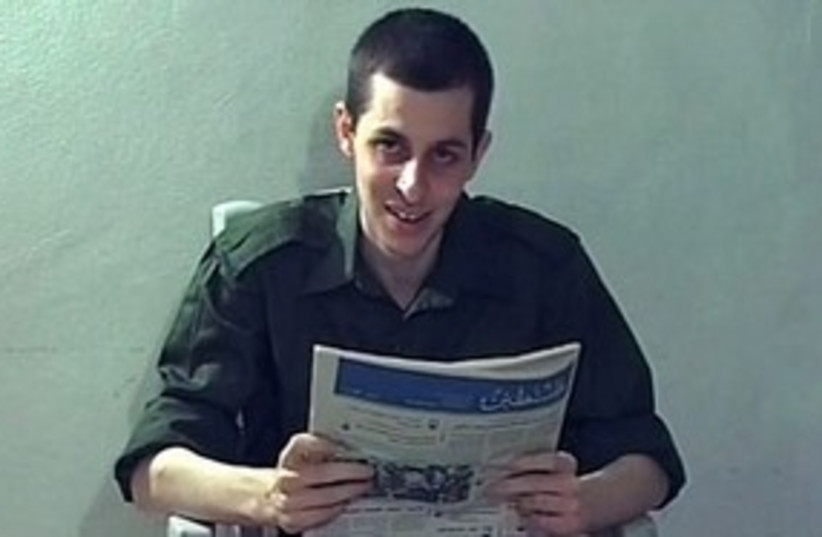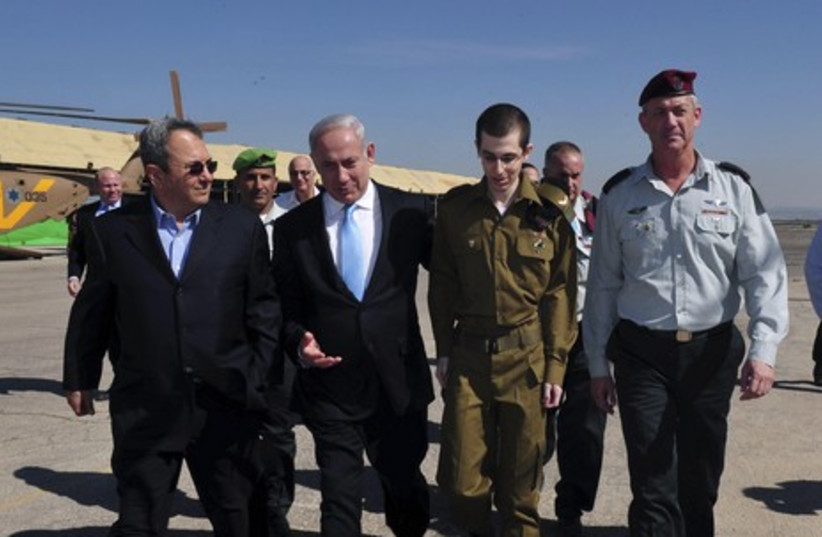On this day in 2011, Gilad Schalit, a former IDF soldier, was released from Gaza after being held captive there by the terrorist group, Hamas, for five years. He was only released when Israel agreed to a prisoner swap that involved the release of 1,027 Palestinian prisoners, including those responsible for killing Israelis in terror attacks.
On the day of his release, Egyptian military officials received Shalit from Hamas control on the Gaza side of the Rafah crossing and updated the IDF command post at the Kerem Shalom crossing of the transaction earlier on Tuesday morning.
As a result, Israel transferred all the Palestinian prisoners to be released to Gaza and the West Bank to Red Cross buses.
Upon passing into Israel, Shalit was guarded by soldiers of the Israel Air Force's 669 unit, who accompanied him until he was home safe in Mitzpe Hila.
As part of a carefully orchestrated prisoner swap, Israel freed 477 Palestinian prisoners on that day, with a further 550 set for release at a later date.

The night before, the IDF finalized preparations for the swap and moved all of the Palestinian prisoners slated for release to various points throughout the country from where they were transferred to Egypt, the Gaza Strip, the West Bank, and inside the country.
From Rafah, Shalit crossed into Israel and was taken to a nearby base for a preliminary medical exam.
According to the official Israeli government site, on June 25, 2006, Schalit, who was 19 at the time, was kidnapped by Hamas terrorists near the Kerem Shalom crossing in southern Israel. Hamas terrorists entered Israeli territory from a 300-meter-long underground passage they had dug.
The terrorists split into three groups after breaching the Israeli side. They initiated a multi-pronged assault that included an attack on a watchtower, an empty armored personnel carrier, and a crucial target - a Merkava Mark III tank.
The ambush was heavily supported by both mortar and anti-tank fire from additional operatives within the Gaza Strip.
The Hamas terrorists employed a rocket-propelled grenade, detonating the tank's rear doors at point-blank range, followed by a barrage of hand grenades thrown inside the tank.
This resulted in two IDF soldiers, St.-Sgt. Pavel Slutzker and Lt. Hanan Barak, being killed in the attack, and one other soldier was wounded. Amidst the chaos, Schalit was seized at gunpoint.
On June 28, 2006, the IDF entered Khan Yunis to search for Schalit.
"Israel did everything it could in exhausting all diplomatic options and gave Mahmoud Abbas the opportunity to return the abducted Israeli," an Israeli embassy spokesperson said at the time.
For five years, Schalit's whereabouts remained unknown to the world, and his condition was a subject of international speculation and concern. The Red Cross was persistently denied access, a move condemned globally as a violation of international humanitarian law.
On October 2, 2009, Israel received a video of Schalit, holding a Falasteen newspaper, and said: "Hello, this is Gilad, son of Noam and Aviva Schalit, brother of Hadas and Yoel, who lives in Mitzpe Hila. My ID number is 397029. As you can see, I am holding today's Falasteen newspaper published in Gaza. I read the newspaper in order to find out information about myself and in hopes of reading about information about my return home and my imminent release."
"I hope the current government, headed by Benjamin Netanyahu, doesn't waste this opportunity to reach an agreement and as a result, allow me to fulfill my dream and be released," he continued. "I want to tell you that I feel weel in medical terms, and that the Mujahidin from the al-Qassam Brigades are treating me excellently."
On May 23, 2011, Prime Minister Benjamin Netanyahu said in a statement, "I think thtat the entire civilized community should join Israel and the United States and all of us in a simple demand from Hamas: Release Gilad Schalit."
Behind the scenes of Schalit's release
During his five years of captivity, there were secret communications, international mediations, and the unyielding perseverance of individuals outside official negotiation channels, according to a report done by Ynet in 2011.

In December 2009, German mediator Gerhard Conrad, tasked with facilitating the negotiation, presented a meticulously drafted 150-page proposal to Ahed Jabari, the then-commander of Izz al-Din al-Qassam Brigades in Gaza.
The document, intended to outline the terms of a prisoner exchange, instead ignited fury.
Jabari, infuriated by the complex legal text, accused Conrad of losing his impartiality and favoring Israeli interests, leading to a prompt and tense suspension of his involvement.
Parallel to these high-stakes negotiations, an unofficial communication line existed, pioneered by Gershon Baskin of the Israel-Palestine Center for Research and Information (IPCRI) and Razi Hamed, a senior Hamas official.
This backchannel, established in the immediate aftermath of Schalit's abduction, was initially overlooked by official Israeli negotiators. Baskin, despite facing dismissal from government envoys, maintained this essential link, believing steadfastly in its potential.
The stalemate persisted until mid-2010 when a potential breakthrough emerged. Hamed provided Basking with a new proposal indicating Hamas' revised stance and willingness to reengage in discussions.
However, this glimmer of hope met resistance. Official channels, adamant about maintaining a singular line of communication, refused to acknowledge the proposal's significance.
Persistence changed the course of events in 2011. The introduction of David Meidan to the negotiation scene marked a renewed approach. Recognizing the untapped potential of the Baskin-Hamed channel, Meidan embraced it, giving "Phoenix" the official nod, it needed.
The deal, which underwent several revisions, finally won the approval of Prime Minister Benjamin Netanyahu. It wasn't until Schalit was safely back in Israel that the extent of missed opportunities became apparent. Meidan, unaware of the 2010 proposal's existence, acknowledged its overlooked value.
'Hamas wanted me alive'
Ten years after Gilad Schalit was released from captivity by Hamas, he spoke to N12 about the time he was held by the terror group in the Gaza Strip, saying that the group wanted to keep him alive since the value of a dead soldier was far less than a living one.
“A living soldier, his value is different from that of a dead soldier. It was important for them to keep me alive,” he said during a talk with Holocaust survivors. While he was afraid that his health might deteriorate, he said: “I was not sick. I was very thin, even now I am thin but I was a little thinner.”
“All in all, as an organization, Hamas wanted to keep me in good shape, in good physical condition,” he said.
Who is Gilad Schalit?
Schalit was born on August 28, 1986, in Nahariya. He is the second child of Aviva and Noam Schalit and grew up alongside his siblings, Yoel and Hadas.
The Schalit family moved to Mitzpe Hila in western Galilee when Gilad was just two, and it was in this tranquil setting that he spent his formative years.
From an early age, Gilad exhibited academic prowess, particularly in the sciences. He graduated with distinction from the science program at Manor Kabri High School, with a special affinity for mathematics.
Known for his well-mannered and quiet demeanor, Gilad was often described as introverted, a young man whose shy, hesitant smile was a staple of his personality.
In October 2018, Schalit celebrated the seven-year anniversary of his release by supporting children with disabilities at the Shalva Israel Gala Dinner.
After his release, Schalit dedicated his time to helping others including his volunteer work with Shalva children.
Shalva provides an array of services for individuals with disabilities.
The Jerusalem Post staff, Sarah Levi, and Anna Ahronheim contributed to this article.
